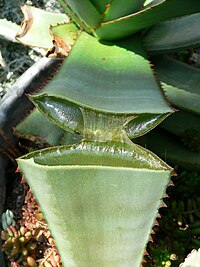
Photo from wikipedia
The genus Beaucarnea (Asparagaceae) has economic value as an ornamental plant but also has ecological importance. Nonetheless, habitat, physiological traits and growth parameters of this species remain largely unknown. We… Click to show full abstract
The genus Beaucarnea (Asparagaceae) has economic value as an ornamental plant but also has ecological importance. Nonetheless, habitat, physiological traits and growth parameters of this species remain largely unknown. We characterized the environmental ranges of Beaucarnea inermis, B. gracilis and B. pliabilis; and screened for the presence of physiological adaptations to drought (biomass allocation, presence of crassulacean acid metabolism (CAM) and its effect on plant water use). We performed experiments in 3- and 5-year-old nursery-grown plants of the three species, measured dry mass accumulation in leaves/stems/roots and screened for CAM using gas exchange, titratable acidity and δ13 C. We performed a second experiment on the water and light use responses of B. pliabilis under drought treatment. We found that B. gracilis was limited to xerophytic scrubs (precipitation > 400 mm yr-1 ), while B. pliabilis and B. inermis (precipitation > 500 and 700 mm yr-1 , respectively) inhabited dry forests. Beaucarnea gracilis had the lowest dry mass and allocation to leaves, while B. inermis showed the opposite pattern. Only B. pliabilis exhibited small but significant acid fluctuations, characterized as weak CAM, along with high proline content. Acid concentration contributed in 2.7 % of the daily carbon during the wet season but represented most of the carbon in the dry season, under closed stomata, and had an important contribution to osmolality. Thus, CAM is described for the first time in the genus Beaucarnea, but was only present in one of three species, warranting exploration of this metabolism in the remaining species of this genus. This article is protected by copyright. All rights reserved.
Journal Title: Physiologia plantarum
Year Published: 2022
Link to full text (if available)
Share on Social Media: Sign Up to like & get
recommendations!